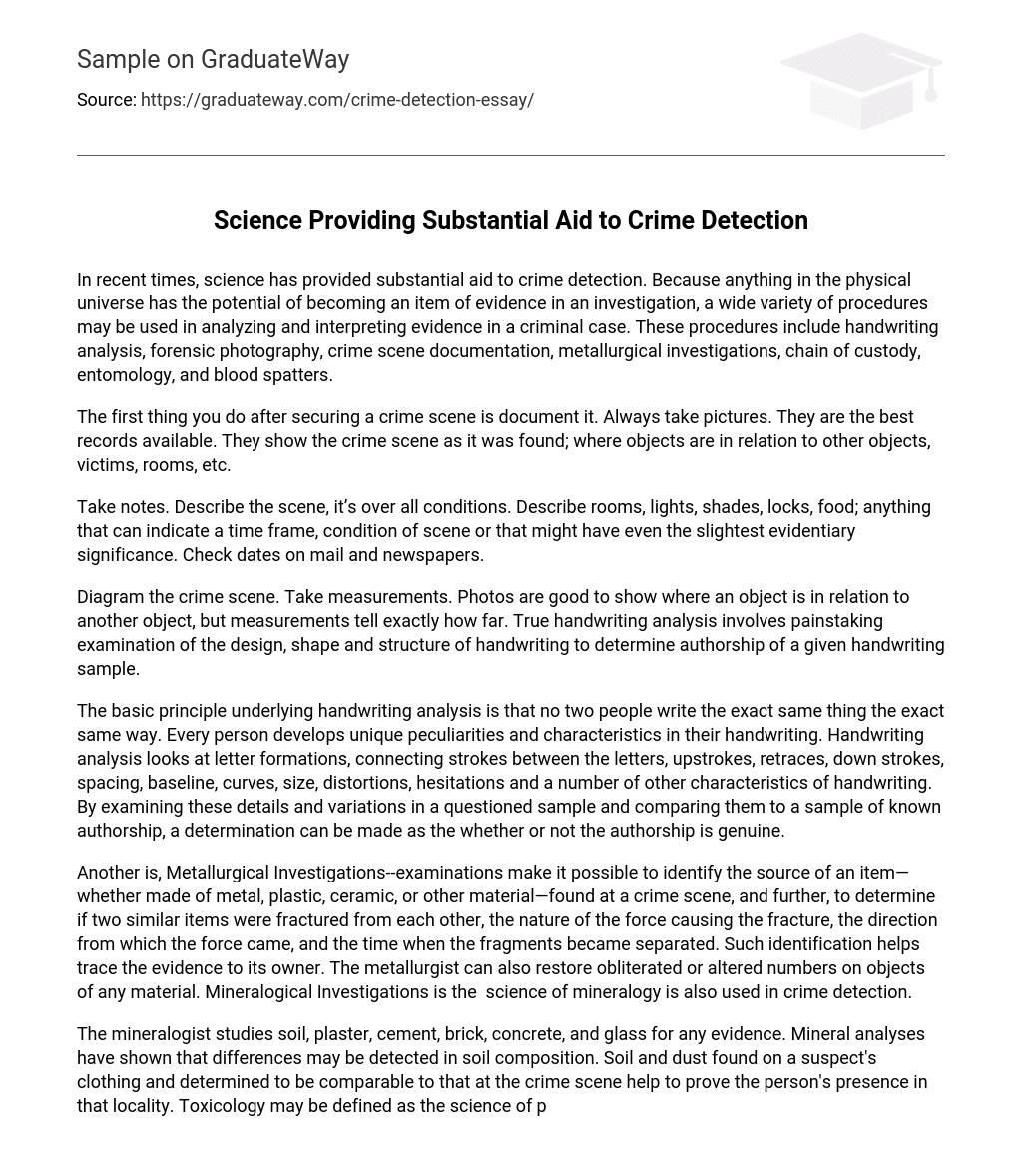In recent times, science has greatly assisted in crime detection by utilizing various procedures for analyzing and interpreting evidence in criminal cases. These procedures encompass handwriting analysis, forensic photography, crime scene documentation, metallurgical investigations, chain of custody, entomology, and blood spatters.
After securing a crime scene, the first step is to document it by taking pictures. Photographs serve as the most reliable records, capturing the scene in its original state and depicting the positions of objects, victims, rooms, and other elements.
When taking notes, be sure to describe the scene in detail, including the overall conditions. This includes describing the rooms, the lighting, any shades or locks present, as well as any indication of time frame or condition of the scene that might have even the slightest evidentiary significance. Additionally, make sure to check the dates on any mail and newspapers found.
To diagram the crime scene, take measurements and photos. While photos can visually show the positioning of objects in relation to one another, measurements provide precise distances. Genuine handwriting analysis entails carefully scrutinizing the design, shape, and structure of handwriting to establish the authorship of a specific handwriting sample.
The main concept behind handwriting analysis is that individuals have distinct writing styles. Each person develops their own unique characteristics and quirks in their handwriting. Handwriting analysis focuses on aspects such as letter shapes, connections between letters, upward and downward strokes, spacing, baselines, curves, size, distortions, hesitations, and various other features of handwriting. By studying these specific details and variations in a questioned document and comparing them to a known sample of the author’s writing, it is possible to determine the authenticity of the authorship.
Metallurgical Investigations allow for the identification of the source and material of an item found at a crime scene, whether it be made of metal, plastic, ceramic, or other materials. It also helps determine if two similar items were fractured from each other, the force and direction that caused the fracture, and the timing of when the fragments separated. This identification is crucial in tracing the evidence back to its owner. Furthermore, metallurgists have the ability to restore altered or erased numbers on objects made of any material. Crime detection also utilizes the science of mineralogy, known as Mineralogical Investigations.
The mineralogist examines various substances such as soil, plaster, cement, brick, concrete, and glass to gather evidence. Analysis of minerals reveals differences in soil composition. Soil and dust discovered on a suspect’s clothing, which are found to be similar to those at the crime scene, serve as proof of their presence in that area. Toxicology, the study of poisons, employs specialized analytical chemistry techniques for toxicological examinations.
Cases of suspected poisoning typically involve examination of tissue samples from vital organs, blood or urine, food, drink, as well as the suspected poison. Firearms are identified based on accidental microscopic imperfections in gun barrels during manufacturing, which are further influenced by subsequent use and wear. Maintaining a proper Chain of Custody is crucial in any investigation.
The chain of custody refers to the unbroken sequence of events involving evidence, from its discovery at the crime scene to its presentation in court. Each step in this process is carefully documented, including the initial discovery, collection of evidence, storage, laboratory analysis, return to storage, and transfer to court. Every step is recorded with the date, time, and person responsible for handling the evidence. If there is a break in the chain of custody and any part of the journey from crime scene to courtroom cannot be accounted for, the evidence becomes inadmissible and irrelevant for the case.
Blood spatters are extremely useful in crime scene reconstruction as they can verify or refute an alibi and help secure a conviction for the guilty party. Analyzing a stain or spatter involves more than simply identifying the location of the crime.
The spatter patterns and shapes of blood droplets can provide insights into how a crime was committed. Spatters from drops falling at varying heights and speeds will have distinct appearances.
When a drop falls from a low height of a few inches, it creates a small cohesive circle. But if the drop falls from a greater height, the circle becomes larger and might have a ‘crown’ effect. The impact of the drop on a surface at an angle further disrupts the blood droplet. However, when the drop hits the surface perpendicular, it remains fairly uniform, as depicted below.
When a droplet hits a surface at an angle, it will bulge out in a specific direction to show the droplet’s travel path. Stain marks caused by blunt force trauma, like being beaten with a hammer, are known as cast off stains. Retracting after a strike results in a blood spatter that creates an arc of blood droplets, which can indicate the direction. To determine the number of impacts, simply count the arcs.
You can also assess the orientation of the individuals involved, the size of the object used, and the right or left handedness of the assailant.





